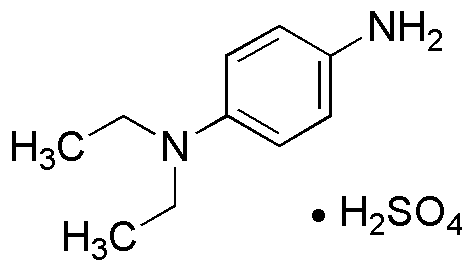N,N-Diethyl-p-phenylenediamine sulfate salt is widely utilized in research focused on:
- Colorimetric Analysis: This compound is commonly used in colorimetric assays to detect and quantify various substances, such as nitrites and nitrates in water samples, providing a simple and effective method for environmental monitoring.
- Textile Industry: It serves as a dye intermediate, particularly in the production of azo dyes, which are essential for coloring fabrics and textiles, offering vibrant colors and excellent fastness properties.
- Cosmetic Formulations: The compound is incorporated into cosmetic products as a colorant and antioxidant, enhancing product stability and providing appealing colors in makeup and skincare items.
- Pharmaceutical Applications: It is utilized in the synthesis of various pharmaceutical compounds, contributing to the development of medications with specific therapeutic effects, thus playing a crucial role in drug formulation.
- Research and Development: In laboratories, it is employed in various chemical reactions and studies, particularly in organic synthesis, aiding researchers in exploring new compounds and their potential applications.
General Information
Properties
Safety and Regulations
Applications
N,N-Diethyl-p-phenylenediamine sulfate salt is widely utilized in research focused on:
- Colorimetric Analysis: This compound is commonly used in colorimetric assays to detect and quantify various substances, such as nitrites and nitrates in water samples, providing a simple and effective method for environmental monitoring.
- Textile Industry: It serves as a dye intermediate, particularly in the production of azo dyes, which are essential for coloring fabrics and textiles, offering vibrant colors and excellent fastness properties.
- Cosmetic Formulations: The compound is incorporated into cosmetic products as a colorant and antioxidant, enhancing product stability and providing appealing colors in makeup and skincare items.
- Pharmaceutical Applications: It is utilized in the synthesis of various pharmaceutical compounds, contributing to the development of medications with specific therapeutic effects, thus playing a crucial role in drug formulation.
- Research and Development: In laboratories, it is employed in various chemical reactions and studies, particularly in organic synthesis, aiding researchers in exploring new compounds and their potential applications.
Documents
Safety Data Sheets (SDS)
The SDS provides comprehensive safety information on handling, storage, and disposal of the product.
Product Specification (PS)
The PS provides a comprehensive breakdown of the product’s properties, including chemical composition, physical state, purity, and storage requirements. It also details acceptable quality ranges and the product's intended applications.
Certificates of Analysis (COA)
Search for Certificates of Analysis (COA) by entering the products Lot Number. Lot and Batch Numbers can be found on a product’s label following the words ‘Lot’ or ‘Batch’.
*Catalog Number
*Lot Number
Certificates Of Origin (COO)
This COO confirms the country where the product was manufactured, and also details the materials and components used in it and whether it is derived from natural, synthetic, or other specific sources. This certificate may be required for customs, trade, and regulatory compliance.
*Catalog Number
*Lot Number
Safety Data Sheets (SDS)
The SDS provides comprehensive safety information on handling, storage, and disposal of the product.
DownloadProduct Specification (PS)
The PS provides a comprehensive breakdown of the product’s properties, including chemical composition, physical state, purity, and storage requirements. It also details acceptable quality ranges and the product's intended applications.
DownloadCertificates of Analysis (COA)
Search for Certificates of Analysis (COA) by entering the products Lot Number. Lot and Batch Numbers can be found on a product’s label following the words ‘Lot’ or ‘Batch’.
*Catalog Number
*Lot Number
Certificates Of Origin (COO)
This COO confirms the country where the product was manufactured, and also details the materials and components used in it and whether it is derived from natural, synthetic, or other specific sources. This certificate may be required for customs, trade, and regulatory compliance.


